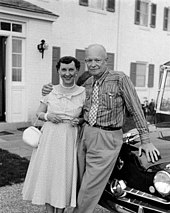Mamie Eisenhower
She kept house and served as hostess for military officers as they moved between various postings in the United States, Panama, the Philippines, and France.
She spent most of her retirement and widowhood at the family farm in Gettysburg, Pennsylvania, before returning to Washington in her final years, where she died in 1979.
[8] Their parents operated under a strict separation of spheres, whereby the father made decisions for the family and the business and the mother ran the household.
[12] At her request, he later gave her a full-size ring, and he formally asked permission to marry her on Saint Patrick's Day.
[13] Mamie's father agreed to the marriage on the condition that Eisenhower did not enter the Army Air Service, as he considered it too dangerous.
[1] Apprehension of American entry into World War I accelerated their plans to wed, and they were married at the Doud family's home in Denver on July 1, 1916.
[14] Eisenhower lived the life of an army wife over the following years, continually moving as her husband was stationed at different posts.
Mamie often attended card parties and luncheons with officers' wives,[10] befriending many of them, but had little patience for the gossip and intrigue that sometimes took place, refusing to take part in it.
[1] She had to grow accustomed to fear and loneliness during periods of separation while her husband was traveling for the army, and Ike once told her that his duty would "always come first".
[7] His birth helped alleviate some of the depression brought about by her firstborn's death and her separations from Ike, and she doted on John well into adulthood.
When Ike was appointed as aide to General Douglas MacArthur in 1929, the family moved to Washington, D.C., and "Club Eisenhower" became a popular social hub for the city's elite.
She initially chose to stay in Washington when her husband was stationed in the Philippines in 1935, and their relationship was strained by the time she joined him the following year.
[10] She continued in her hosting duties, this time for faculty wives and large donors in addition to the friends her husband had made in the military.
[7] Ike was then made commander of the North Atlantic Treaty Organization forces, and their return to Paris delayed work on their dream home, which was not completed until 1955.
[23] In Europe, the two regularly received royals, and Mamie was awarded the Cross of Merit for her role in her husband's military success.
[10] She sometimes subverted her husband's campaign managers' wishes, making speaking appearances without their knowledge and suggesting changes to his speeches.
[10] She maligned the attention associated with the role, insisting that her husband was the public figure of the family and generally refusing to take on duties outside the White House.
[7] She maintained distance from the press, avoiding interviews and having her secretary Mary Jane McCaffree address reporters in her stead.
[26] She also declined a request to write a column for the New York Herald Tribune, and held only one press conference during her tenure.
[28] Eisenhower typically managed the White House from her bedroom, staying in bed due to her poor health.
[30] Her attempts to decorate the White House were complicated by lack of federal funding, and many of her changes depended on private donations.
[2] Mamie also had medical concerns of her own; among others, she was uneasy on her feet due to Ménière's disease, an inner-ear disorder that affects equilibrium, which fed rumors that she had a drinking problem.
[2] This lack of political involvement contributed to her subservient image that protected her from heavy media scrutiny and bolstered her popularity.
Most of her influence in the Oval Office came through her social role; she made a point of knowing the president's cabinet members and support staff, and congratulated them and their wives on successes to improve morale.
[37] She made appearances on occasion for the Kennedy administration, including a fundraiser for the National Cultural Center and a state dinner with the Prime Minister of Japan.
[11] She took stronger political stances later in life; she supported the Vietnam War, though she recognized the hardship faced by American soldiers, and opposed the women's liberation movement.
Her style was known as the "Mamie Look"; it involved a full-skirted dress, pink gloves, charm bracelets, pearls, little hats, purses, and bobbed, banged hair.
[49] Eisenhower first adopted her iconic bangs while Ike was stationed in Panama; she found that the hairstyle helped her keep cool in the tropical environment, and decided to keep it after returning to the United States.
[2] She played the role of the "perfect wife" of her era: highly feminine, subservient to her husband, and focused on the household.
[25] Since 1982, Siena College Research Institute has periodically conducted a survey asking historians to assess American first ladies according to a cumulative score on their background, value to the country, intelligence, courage, accomplishments, integrity, leadership, being their own women, public image, and value to the president.








